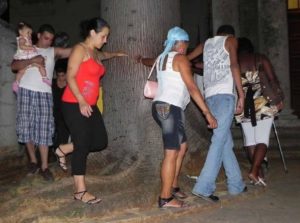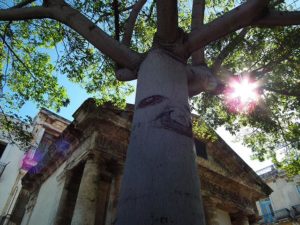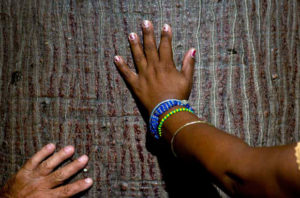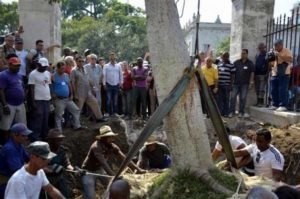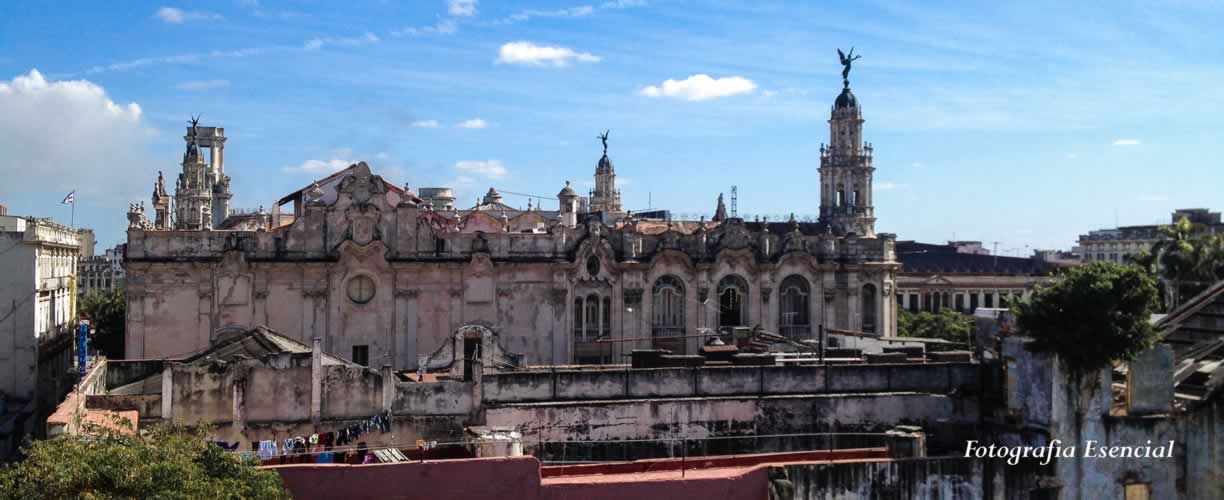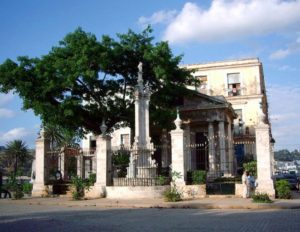 LA HABANA Y LA CEIBA DEL TEMPLETE, EL ARBOL DE LOS DESEOS.
LA HABANA Y LA CEIBA DEL TEMPLETE, EL ARBOL DE LOS DESEOS.
En la Habana y de todas partes, incluso de otras provincias, los cubanos continúan dando vida a una tradición tan antigua como la propia Villa. Cada 16 de noviembre —fecha en que se fundó San Cristóbal de La Habana— el lugar es visitado por cientos de personas, que no siempre esperan la medianoche para realizar el ritual, y desde horas tempranas del día hacen sus ruegos con el propósito de evitar las aglomeraciones y las largas colas. Algunos le echan quilos prietos, monedas, pero lo cierto es que hombres, mujeres y niños —silenciosos o no— dejan allí, a su resguardo, confidencias, deseos y aspiraciones. Tres vueltas en sentido contrario a las manecillas del reloj. La gente la acaricia una y otra vez, como si fuera una deidad. La ceiba de El Templete.
Cuestiones de salud, ansias de casamiento o de viajes, y hasta solución de conflictos maritales u otros personales se le “piden” a este árbol de gran significación para algunas religiones, que en las de origen africano representa a Iroko.
LEYENDAS, CREENCIAS E HISTORIAS PASADAS.
Sobre esta ceiba, situada a los pies de El Templete —singular espacio diminuto, de arquitectura neoclásica, en cuyo estrecho recinto descansan los restos del pintor francés Jean Bautista Vermay (1786-1833), y donde según se cuenta se celebró el primer cabildo de la ciudad— se han tejido disímiles leyendas.
El sabio etnólogo cubano Don Fernando Ortiz, según narra la literatura consultada, en su opinión, el simbolismo de la ceiba no era eminentemente religioso. “Creemos que la ceiba del Templete —afirmó categórico— fue el emblema de la municipalidad de la villa de la Habana y el más antiguo y permanente emblema de libertades ciudadanas que conservamos en Cuba”.
Desde entonces ha llovido mucho, más la tradición se mantiene, no solo por quienes practican alguna religión sino por todos aquellos que siembran sus esperanzas en que las tres vueltas, los deseos y el dinero depositado en sus raíces puedan dar resultados.
LA NUEVA CEIBA
A principios del año 2016 un acontecimiento singular detuvo allí la mirada: una brigada de la empresa constructora Puerto Carenas, de la Oficina del Historiador de la Ciudad retiró en la mañana del martes 9 de febrero la ceiba que ya llevaba 56 años en el sitio, debido a su marcado deterioro por los estragos del comején.
Según se cuenta, la primera de estas ceibas murió a mediados del siglo XVIII, y a partir de entonces tales ejemplares han sido reemplazados varias veces desde que el gobernador el capitán Francisco Cagigal de la Vega (ortodoxo y profanador de monumentos históricos) mandara a cortar la primigenia.
Hoy en El Templete, todavía no muy frondosa por su “juventud”, vive la sembrada en marzo de este año —apenas un mes y unos días luego de haber sido desenterrada la anterior—, que sin dudas continuará siendo todo un ícono de la ciudad maravilla, a la cual le han cantado los más inspirados poetas y compositores.
La ceiba es considerada la casa de todos los santos — ahora con apenas 15 años de vida y ocho metros de altura, nativa de la comunidad Las Terrazas, en Artemisa— se apresta también a las festividades este 16 de noviembre por el aniversario 500 de San Cristóbal de La Habana. Es el árbol sagrado de la religión afrocubana, también de los mayas, de los aztecas de los incas. Existen controversias en cuanto a los nombres de la ceiba y de Iroko. La Ceiba, siempre ha sido llamada Araba en Nigeria, e Iroko sería la caoba.
 LA HAVANA AND THE CEIBA DEL TEMPLETE, THE TREE OF WISHES.
LA HAVANA AND THE CEIBA DEL TEMPLETE, THE TREE OF WISHES.
In Havana and everywhere, even in other provinces, Cubans continue to give life to a tradition as old as Villa itself. Every November 16 – date on which San Cristóbal de La Habana was founded – the place is visited by hundreds of people, who do not always wait for midnight to perform the ritual, and from early in the day they make their prayers in order to avoid the crowds and the long lines. Some give him tight fifths, coins, but the truth is that men, women, and children – silent or not – leave there, to their shelter, confidences, desires, and aspirations. Three turns counterclockwise. People caress her again and again as if she were a deity. The ceiba of El Templete.
Health issues, anxieties of marriage or travel, and even the solution of marital or other personal conflicts are “asked” for this tree of great significance for some religions, which in those of African origin represents Iroko.
LEGENDS, BELIEFS AND PAST STORIES.
On this ceiba, located at the foot of El Templete —sing tiny space, of neoclassical architecture, whose narrow enclosure rests the remains of the French painter Jean Bautista Vermay (1786-1833), and where it is said that the first town hall was held the city — different legends have been woven.
The wise Cuban ethnologist Don Fernando Ortiz, according to the literature consulted, in his opinion, the symbolism of the ceiba was not eminently religious. “We believe that the ceiba of the Templete – he affirmed categorically – was the emblem of the municipality of the town of Havana and the oldest and most permanent emblem of citizen liberties that we conserve in Cuba.”
Since then it has rained a lot, but the tradition is maintained, not only by those who practice some religion but by all those who sow their hopes that the three turns, the desires and the money deposited in their roots can give results.
THE NEW CEIBA
At the beginning of 2016, a unique event stopped there: a brigade from the construction company Puerto Carenas, from the Office of the City Historian, retired on the morning of Tuesday, February 9, the ceiba tree that had already been 56 years on the site, due to its marked deterioration by the ravages of the termite.
According to the report, the first of these ceibas died in the middle of the 18th century, and from then on, such copies have been replaced several times since Governor Captain Francisco Cagigal de la Vega (Orthodox and desecrator of historical monuments) ordered to cut the Primal
Today in El Templete, still not very leafy because of its “youth,” it is planted in March of this year – just a month and a few days after the previous one was unearthed – which will undoubtedly continue to be an icon of the city wonder, to which the most inspired poets and composers have sung.
The ceiba is considered the house of all saints – now with just 15 years of life and eight meters high, native of the Las Terrazas community, in Artemisa – is also preparing for the festivities this November 16 for the 500th anniversary of San Cristóbal de La Habana. It is the sacred tree of the Afro-Cuban religion, also of the Maya, of the Aztecs of the Incas. There are controversies regarding the names of the ceiba and Iroko. La Ceiba has always been called Araba in Nigeria, and Iroko would be mahogany.
Agencies/ RHC/ Alina M. Lotti/ Extractos/ Excerpts/ Internet Photos/ Arnoldo Varona/ www.TheCubanHistory.com
THE CUBAN HISTORY, HOLLYWOOD.



 < LA HAVANA and the 'Ceiba del Templete', the Tree of Wishes. Photos.
< LA HAVANA and the 'Ceiba del Templete', the Tree of Wishes. Photos.